|
Boletín de la Sociedad Geológica Mexicana Volumen 72, núm. 2, A090619, 2020 |
 |
Late Triassic scleractinian corals from Nayband Formation, southwest Ardestan, Central Iran
Corales escleractínidos del Triásico tardío de la Formación Nayband, suroeste de Ardestán, Irán central
Maryam Mannani1,*
1 Assistant Professor, Department of Geology, Payame Noor University, 19395-4697 Tehran, I. R of Iran.
* Corresponding author: (M. Mannani) This email address is being protected from spambots. You need JavaScript enabled to view it.
How to cite this article:
Mannani, M., 2020, Late Triassic scleractinian corals from Nayband Formation, southwest Ardestan, Central Iran: Boletín de la Sociedad Geológica Mexicana, 72 (2), A090619. http://dx.doi.org/10.18268/BSGM2020v72n2a090619
Abstract
Late Triassic coral fauna from the Nayband Formation, southwest of Ardestan town (Central Iran), is represented by solitary, phaceloid and colonial (cerioid, meandroid, thamnasterioid, and plocoid) growth forms, attributed to 14 genera and 24 species. They occur in biostromal bioconstructions, in Bidestan and Howz-e-Khan Members of Nayband Formation. Sponges and corals are the main reef-building organisms in these biostromes, and occur together with hydrozoan Heterastridium spp., bivalves, and other reef dwellers (e.g., echinoderms, gastropods, and brachiopods). The corals of the studied area bear taxonomic resemblance to the Late Triassic corals from Northern Calcareous Alps and Pamirs, Central Asia.
Keywords: Scleractinian corals, Late Triassic, Nayband Formation, Ardestan, Iran.
Resumen
La fauna coralina del Triásico tardío de la Formación Nayband en el suroeste de Ardestan (Irán Central) está representada por formas de crecimiento solitario, faceloide y colonial (cerioides, meandroides, thamnasterioides y plocoides), atribuidas a 14 géneros y 24 especies. Dichos corales se encuentran en bioconstrucciones de biostromas, en los miembros Bidestan y Howz-e-Khan de la Formación Nayband. Esponjas y corales representan los principales organismos constructores de estos biostromas, y se encuentran asociados al hidrozoo Heterastridium spp., bivalvos y otros habitantes del arrecife (e.g., echinodermos, gasterópodos y braquiópodos). Los corales del área de estudio tienen similitud taxonómica con corales del Triásico tardío de los Alpes Calcáreos del Norte y Pamir, Asia Central.
Palabras clave: Corales escleractinios, Triásico tardío, Formación Nayband, Ardestan, Irán.
- Introduction
Upper Triassic sediments are widely exposed in central and northern Iran. Particularly abundant and taxonomically diverse Triassic marine invertebrate fauna is known from the Late Triassic Nayband Formation (name taken from the Nayband Mountain, 3008 m.a.s.l.), east of the small village of Naybandan (south of Tabas). The pioneering study on Nayband Formation strata was carried out by Douglas (1929), who subdivided the Nayband Formation into three members: (i) Howz-e-Sheikh, (ii) Nayband, and (iii) Howz-e-Khan. Sedimentology, biostratigraphy, and paleontology of this lithostratigraphic unit have been outlined by Brönnimann et al. (1971), Seyed-Emami (1971, 2003), Zahedi (1976), Kluyver et al. (1983), Fürsich et al. (2005), and Hautmann (2001). Several authors published studies on sponges, gastropod, and bivalve mollusks from the Nayband Formation (e.g., Douglas, 1929; Fallahi et al., 1983; Nützel and Senowbari-Daryan, 1999; Repine, 1996; Hautmann, 2001; Nützel et al., 2003, 2010).
To date, only Shepherd et al. (2012) described Norian to Rhaetian scleractinian corals from the Nayband Formation (14 taxa), which were collected from the Ferdows patch reef in the Bidestan and Howz-e-Khan members. Remarkably, nine species of the scleractinian corals of the Ferdows area were also described in 40 Km of the southwest of Ardestan town. Many of these taxa were also reported from Tajikistan (Melnikova, 2001). This distribution indicates paleobiogeographic relationships with other parts of the Tethys Ocean in the Late Triassic. The purpose of this study is to provide more extensive description of Late Triassic (Norian to Rhaetian) scleractinian coral fauna from Nayband Formation recognized in two sections located in Bagher Abad and Dizlu in the southwest of Ardestan town.
- Geological setting
The corals described (Table 1) were collected from the Nayband Formation, in 40 km southwest of the town of Ardestan, from the outcrops 5 km east of Dizlu village (33°04’10’’N, 52°01’40’’E) (Figure 1C), and in the locality situated 15 km northeast of Bagher Abad village (33°05’28’’N, 52°03’27’’E) (Figure 1B).
| Table 1. Scleractinian corals from the Upper Triassic of Nayband Formation in the southwest of Ardestan. |
  |
The Nayband Formation is subdivided into the following (from bottom to top): Gelkan (shales and sandstones), Bidestan (oolithic limestones, sandstones, and reefal limestones with numerous algae, calcareous sponges, and corals), Howz-e-Sheikh (shales and sandstones), and Howz-e-Khan members (reefal limestones with algae, calcareous sponges, and corals). In addition, upper part of Nayband formation is Qadir member that overlay the Howz-e-Khan member. (Brönnimann et al., 1971; Kluyver et al., 1983; Fürsich et al., 2005).
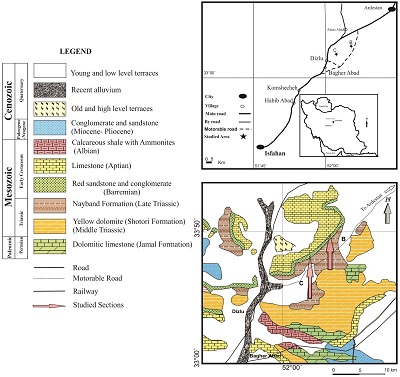 |
|
Figure 1. Geological map and location of the studied sections in the southwest of Ardestan, B. Bagher Abad, and C. Dizlu section. |
In the Dizlu area, the Nayband Formation has five members (Figure 2A). Lowermost part of Nayband formation is Gelkan Member (up to 400 m thick), which deposits on the Shotori formation (Middle Triassic) (Figure 2B). The Bidestan Member (Biostrome 1) lying conformably on the Gelkan member, the Bidestan member is about 11 m thick, with oolithic limestone at the base member, and biostromal bioconstructions (Figure 2C and 2D). In the biostromes, sponges and corals are the main reef-building organisms; hydrozoan Heterastridium spp. and bivalves are also relatively abundant. A list of corals is presented in Table 2. This assemblage indicates the late Norian–Rhaetian age of fauna (Figure 4). The Bidestan Member is overlain by the Howz-e-Sheikh member, which reaches a thickness of 44 m and consists mainly of light brown unfossiliferous sandstones (Figure 2E). The Howz-e-Khan Member, which is up to 15 m thick, rests on the Howz-e-Sheikh Member and starts with a thick limestone bed (Figure 2F). The member contains abundant reef organisms, including sponges, corals, and reef dwellers (e.g., echinoderms, bivalves, gastropods, and brachiopods) (Figure 4). The corals (Table 2) indicate the Rhaetian age of the Howz-e-Khan member. The uppermost Qadir Member, up to 200 m thick, comprises brown sandstones and marls. Two key horizons in the Qadir member contain bivalves (Indopecten glabra) and flora (Clathropteris spp.), which indicate a Rhaetian age (Figures 2G and 2H). The Nayband Formation is overlain with an angular unconformity by Early Cretaceous deposits.
| Table 2. Distribution of Corals in the Norian to Rhaetian of the southwest of Ardestan. |
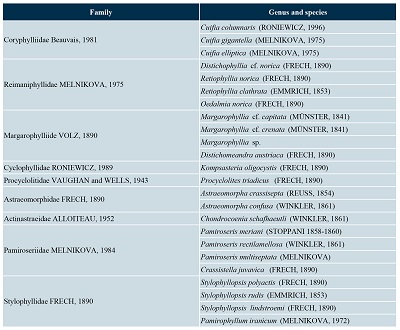 |
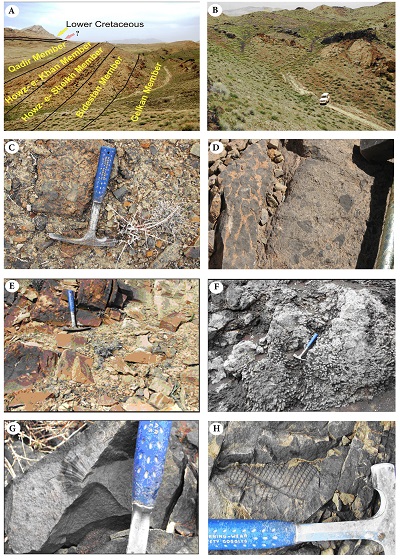 |
| Figure 2. Exposures of Late Triassic deposits of the Nayband Formation, Dizlu area, southwest of Ardestan town. (A) Field view of the rocks assigned to the Nayband Formation. (B) Alternated brown sandstone and marl, Gelkan Member. (C) Reefal limestone, Bidestan Member. (D) Scleractinian corals in limestone, Bidestan Member. (E) Alternated brown sandstones and marls, Howz-e-Sheikh Member. (F) Reefal limestone, Howz-e-Khan Member. (G) Bivalve key bed, Qadir Member. (H) Flora key horizon, Qadir Member. |
In the Bagher Abad area, the Nayband Formation starts with the Howz-e-Khan Member. The Qadir Member is overlain by Early Cretaceous beds (Figures 3A). The Howz-e-Khan Member, up to 25 m thick, is formed by cream to light-gray reefal limestone (Figures 3B and 3C), and contains abundant reef organisms, including: sponges, corals, and reef dwellers (e.g., echinoderms, bivalves, gastropods, and brachiopods) (Figure 5).The corals (Table 2) indicate a Rhaetian age for the Howz-e-Khan Member. The Qadir Member, up to 125 m thick, contains brown sandstones and marls. One of the key beds in the Qadir Member, the Nayband formation, is overlain with an angular unconformity by Early Cretaceous deposits.
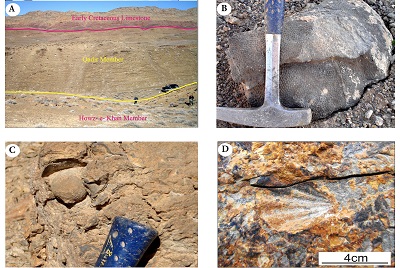 |
|
Figure 3. Exposures of Late Triassic deposits of the Nayband Formation, Bagher Abad area, southwest of Ardestan. (A) Field view of Nayband Formation rock exposures. (B) Scleractinian coral colony in reefal limestone, Howz-e-Khan member. (C) Hydrozoan Heterastridium sp. in limestone of Howz-e-Khan member. (D) Bivalve key bed, Qadir member. |
- Materials
The material examined consists of 88 specimens, represented by eight scleractinian families. Several coralla were sectioned to check preservation of the original structure. Coralla are typically completely recrystallized with blocky calcite crystals composing the skeletal structures. A few samples were also examined by cathodolumienscence microscopy (at the Institute of Paleobiology, Polish Academy of Sciences) in order to assess diagenetic patterns. Macroscopically, coralla are generally well preserved and major diagnostic features are recognizable, i.e., septa, axial structures, walls. Some traces of micromorphological features are sometimes visible (e.g., septal granulations).The repository location is housed at the Univeristy of Payame-Noor, under the symbol “SH-PNUICO” (Shahin shahr Payame Noor University Iran Coral) (8378–8467).
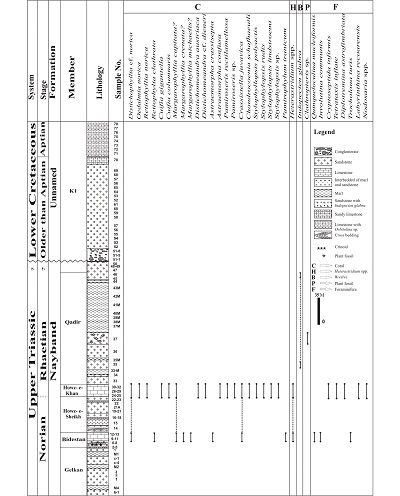 |
| Figure 4. Biostratigraphic range chart of Late Triassic fauna from the Nayband Formation, Dizlu area, southwest of Ardestan. |
In (8378–8467) are shown: The code number of museum samples in Shahin shahr Payame Noor University.
Abbreviations used in the text include the following:
c-c: distance between the calicular axes,
d: diameter of juvenile corallite,
D: diameter of adult corallite,
GCD: greater calicular diameter,
LCD: smaller calicular diameter,
H: height of the solitary coral or colony,
S: number of septa; S1, S2 …etc.,
S/mm: septal density measured at the calicular wall.
- Systematic paleontology
Order Scleractina BOURNE, 1900
Family Coryphylliidae BEAUVAIS, 1981
Genus Cuifia MELNIKOVA, 1975
Type species: Cuifia gigantella Melnikova, 1975
Cuifia columnaris RONIEWICZ, 1996
Figures 7A and 7B
1996 Cuifia columnaris: RONIEWICZ,
21, pl. 3, figs. 1-3; pl. 4, figs. 1, 4, 5
2001 Cuifia columnaris RONIEWICZ:
MELNIKOVA, p. 43, pl. 11, fig. 1
Material: One specimen (SH-PNUICO8408) from Biostrome 2, Section C, Dizlu area. Measurements (in mm):

Description: The coral is characterized by solitary corallum of sub-cylindrical shape, circular and deep calice of a considerable diameter, thick septa and granulation on septal faces. Radial elements are numerous, differentiated into more than 3 size orders. Endotheca is formed by vesicular dissepiments. Wall thick, epithecal surface is destroyed. The corallum shows superposed growth stages with smaller or larger calicular diameters, which resulted from development in succeeding changes of paleoenvironmental conditions.
Occurrence: Late Triassic, Rhaetian, Howz-e-Khan Member, Dizlu, southwest of Ardestan, Central Iran.
The species is known from the upper Norian and Rhaetian of the European and Asian parts of the Tethys.
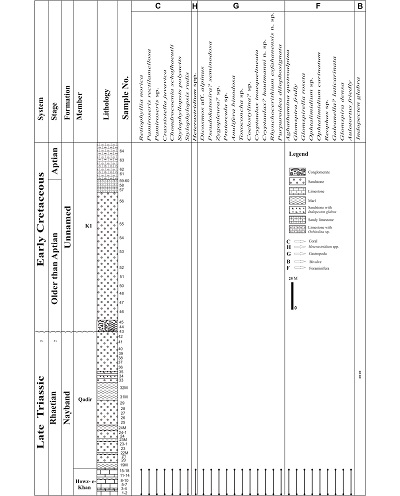 |
| Figure 5. Biostratigraphic range of Late Triassic fauna from the Nayband Formation, Bagher Abad area, southwest of Ardestan. |
Cuifia gigantella MELNIKOVA, 1975
Figures 7G and 7H
1975 Cuifia gigantella: MELNIKOVA, p. 83,14, figs. 1, 2
2001 Cuifia gigantella MELNIKOVA, p. 42, pl. 10, figs. 1, 2
Material: One specimen (SH-PNUICO8406) from Biostrome 2, Section C, Dizlu area. Measurements (in mm):

Description: Corallum solitary, low-conical in shape, calice circular, slightly deepened, septa of the first size order thick and high, granulation on septal faces. Septa arranged into 4 size orders: the septal blades of the S1 septa continue to axial cavity, septal blades of the S2 septa are half of the S1 septa in thickness, the S3 septa are thinner and shorter than the S2 septa, and septal blades of the S4 septa are thin and the shortest of all. Wall epithecal, thick, partly destroyed.
Occurrence: Late Triassic, Rhaetian, Howz-e-Khan Member, Dizlu, southwest of Ardestan, Central Iran.
The species is known from the Norian–Rhaetian of the Pamir Mountains.
Cuifia elliptica MELNIKOVA, 1975
Figures 7C to 7F
1975 Cuifia elliptica: MELNIKOVA, p. 84, pl. 14, figs. 3–5
1989 Coryphyllia elliptica (Melnikova): RONIEWICZ, p. 65, pl. 15, figs. 1, 2, 7
2001 Cuifia elliptica MELNIKOVA:
MELNIKOVA, p. 43, pl. 11, figs. 2–4
Material: Two specimens (SH-PNUICO8405, 8407) from Biostrome 2, Section C, Dizlu area.Measurements (in mm):

Description: The specimen SH-PNUICO8405 is characterized by size and form, typical of C. elliptica. The longest septa of two size orders reach to the center: the S1 septa continue to the axial fossa, septal blades of the S2 septa are slightly shorter and thinner than the S1 septa; other septa are shorter depending on the order. Epitheca is destroyed. This corallum developed in variable environmental conditions, which resulted in formation of superposed stages of rejuvenation. At the rejuvenated stage, the wall is very thick.
Occurrence: Late Triassic, Rhaetian, Howz-e-Khan Member, Dizlu, southwest of Ardestan, Central Iran.
The species is known from the Norian–Rhaetian of the Pamir Mountains.
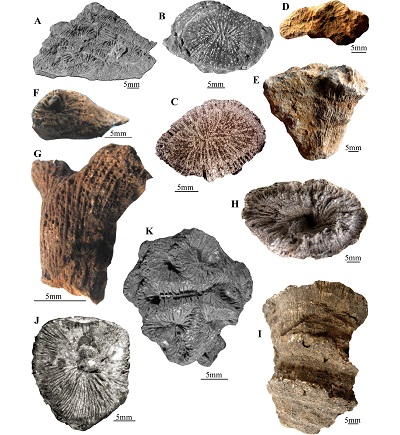 |
| Figure 6. Scleractinian corals from the Nayband Formation, southwest of Ardestan, Iran. (A) Oedalmia norica (Frech, 1890) SH-PNUICO8424, Biostrome 2, Section C, Dizlu area. Colony in calicular view. (B–E) Retiophyllia norica (Frech, 1890). (B, C) SH-PNUICO8466, Biostrome 2, Section C, Dizlu area. (B) Colony in calicular view. (C) Colony in transverse section. (D, E) SH-PNUICO8428, Biostrome 2, Section B, Bagher Abad area. (D) Colony in calicular view. (E) Colony in side view. (F, G) Retiophyllia clathrata (Emmrich, 1853). SH-PNUICO8429, Biostrome 1, Section C, Dizlu area. (F) Colony in calicular view. (G) Colony in side view. (H, I) Distichophyllia cf. norica (Frech, 1890) SH-PNUICO8426, Biostrome 1, Section C, Dizlu area. (H) Corallum in calicular view. (I) Corallum in side view. (J) Procyclolites triadicus (Frech, 1890). SH-PNUICO8401, Biostrome 1, Section C, Dizlu area. Corallum in calicular view. (K) Distichomeandra cf. austriaca (Frech, 1890). SH-PNUICO8432, Biostrome 2, Section C, Dizlu area. Colony in calicular view. |
Family Reimaniphylliidae MELNIKOVA, 1975
Genus Distichophyllia CUIF, 1974
Type species: Montlivaltia norica FRECH, 1890
Distichophyllia cf. norica (FRECH, 1890)
Figures 6H and 6I
Material: Two specimens (SH-PNUICO8426, 8427) from Biostrome 1, Section C, Dizlu area.Measurements (in mm):

Description: The coral is similar in general features to Distichophyllia norica (Frech, 1890), but its state of preservation does not allow for detailed examination of specific features of the skeleton. Septa may reach to the axial cavity. Radial elements are differentiated into at least 3 size orders, from which the septa S1 reach to the calicular fossa, Endotheca is vesicular. Epitheca is destroyed.
Occurrence: Late Triassic, Norian–Rhaetian, Bidestan Member, Dizlu, southwest of Ardestan, Central Iran.
Frech (1890) described Montlivaltia norica from Grosser Zlambachgraben (holotype), Hallstätter Salzberg and Scharitzkehlalp. According to Roniewicz (1989) the species is present in the Rhaetian of the Northern Calcareous Alps: in the Zlambach Beds of Fischerwise, Kesselwand-Rohrmoos, and Schneckengraben. Species common in the European and Asiatic parts of Tethys, and according to Stanley (1986), present in the Norian of North America.
 |
| Figure 7. Scleractinian corals from the Nayband Formation, southwest of Ardestan, Central Iran, Iran. (A, B) Cuifia columnaris (Roniewicz, 1996). SH-PNUICO8408, Biostrome 2, Section C, Dizlu area. (A) Corallum in calicular view. (B) Corallum in side view. (C–F) Cuifia elliptica (Melnikova, 1975). (C–E) SH-PNUICO8405, Biostrome 2, Section C, Dizlu area. (C) Corallum in calicular view. (D) Corallum in side view. (E) Corallum in transverse section. (F) SH-PNUICO8407, Biostrome 2, Section C, Dizlu area. Corallum in calicular view. (G, H) Cuifia gigantella (Melnikova, 1975). SH-PNUICO 8406, Biostrome 2, Section C, Dizlu area. (G) Corallum in calicular view. (H) Corallum in proximal view. (I) Kompsasteria oligocystis (Frech, 1890). SH-PNUICO8433, Biostrome 2, Section C, Dizlu area. Colony in transverse section. |
Genus Retiophyllia CUIF, 1966
Type species: Retiophyllia frechi Roniewicz, 1989
Retiophyllia norica (FRECH, 1890)
Figures 6 B to 6E
1890 Thecosmilia norica:FRECH, p. 9, pl. 1, figs. 14–24 (non pl. 10, fig. 6)
1989 Retiophyllia norica (FRECH): RONIEWICZ, p. 52, pl. 8, figs. 5–8; pl. 9, fig. 2; pl. 14, figs. 1, 2
Material: Two specimens (SH-PNUICO8466, SH-PNUICO8467) from Biostrome 2, Section C, Dizlu area and one specimen (SH-PNUICO8428) from Biostrome 2, Section B, Bagher Abad area.
Measurements (in mm):

Description: Corallum phaceloid. The specimen SH-PNUICO8426 shows corallites bifurcating with obtuse angle. Septa fusiform, differentiated into 3–4 orders. Septal blades of S1 septa continue to the center, the remaining septa are shorter in the order.
Occurrence: Late Triassic, Rhaetian, Howz-e-Khan Member, Dizlu and Bagher Abad, southwest of Ardestan, Central Iran.
The species is known from the Rhaetian of the Northern Calcareous Alps: Zlambach Beds of Fischerwise and Zlambachgraben (Frech, 1890; Roniewicz, 1989). Stanley (1986) mentioned this species in the Norian of North America.
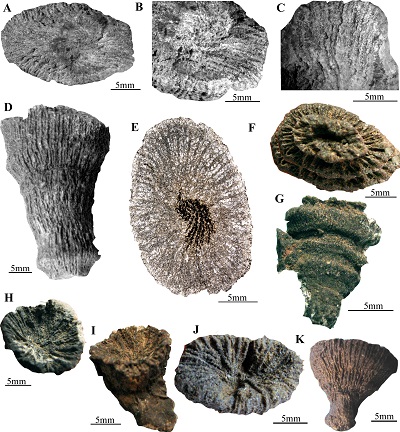 |
| Figure 8. Scleractinian corals from the Nayband Formation, southwest of Ardestan, Central Iran, Iran. (A–G) Margarophyllia cf. crenata (Münster, 1841). SH-PNUICO8414, Biostrome 1, Section C, Dizlu area. (A) Corallum in calicular view. (B) Corallum in microstructure view. (C) Corallum in microstructure view. (D) Corallum in side view. (E) Corallum in transverse section. (F, G) SH-PNUICO8412, Biostrome 1, Section C, Dizlu area. (F) Corallum in calicular view. (G) Corallum in side view. (H, I) Margarophyllia cf. capitata (Münster, 1841) SH- PNUICO 8415, Biostrome 1, Section C, Dizlu area. (H) Corallum in calicular view. (I) Corallum in side view. (J, K) Margarophyllia sp. SH-PNUICO8416, Biostrome 1, Section C, Dizlu Area. (J) Corallum in calicular view. (K) Corallum in side view. |
Retiophyllia clathrata (EMMRICH, 1853)
Figures 6F to 6G
1853 Lithodendron clathratum: EMMRICH, p. 78
1890 Thecosmilia clathrata EMMRICH: FRECH, p. 15, pl. 4, figs. 1–5, 7–11
1974 Retiohyllia clathrata (Emmrich): RONIEWICZ, p. 108, pl. 4, fig. 1, pl.5, figs. 3, 7
Material: Two specimens (SH-PNUICO8429 and SH-PNUICO8430) from Biostrome 1, Section C, Dizlu area. Measurements (in mm):

Description: The specimen SH-PNUICO8430 is characterized by phaceloid corallum, corallites bifurcating or trifurcating. The species shows a simple division of septal apparatus. Ornamentation is granular. Septa are differentiated into 2–3 size orders. Dissepiments are vesicular.
Occurrence: Late Triassic, Norian–Rhaetian, Bidestan Member, Dizlu, southwest of Ardestan, Central Iran.
The species is characteristic for the Rhaetian of the Alps and Carpathians. Similar corals under different specific names were described from the Norian of North America (Calamophyllia suttonensis in Clapp & Shimer, 1911; Thecosmilia fenestrata (Reuss) in Smith, 1927, and from South America (Thecosmilia sp. indet in Maeda et al., 1974).
 |
| Figure 9. Scleractinian corals from the Nayband Formation, southwest of Ardestan, Central Iran, Iran. (A, B) Pamiroseris rectilamellosa (Winkler, 1861). (A) SH-PNUICO8449, Biostrome 2, Section B, Bagher Abad area. Colony in calicular view. (B) SH-PNUICO8450, Biostrome 2, Section B, Bagher Abad area. Colony in transverse section. (C, D) Pamiroseris multiseptata (Melnikova, 1975). (C) SH-PNUICO8457, Biostrome 2, Section B, Bagher Abad area. Colony in calicular view. (D) SH-PNUICO8458, Biostrome 2, Section C, Dizlu area. Colony in calicular view. (E, F) Pamiroseris meriani (Stoppani, 1858-1860). SH-PNUICO8462, Biostrome 2, Section C, Dizlu area. (E) Colony in calicular view. (F) Colony in transverse section. |
Genus Oedalmia CUIF, 1976
Type species: Thamnastraea norica FRECH, 1890
Oedalmia norica (FRECH, 1890)
Figure 6A
1890 Thamnastraea norica nov. sp.: FRECH, p. 63, pl. 17, figs.1–6
1989 Oedalmia norica (FRECH, 1890): RONIEWICZ, p. 62, pl. 15, figs. 3–6
Material: One specimen (SH-PNUICO8424) from Biostrome 2, Section C, Dizlu area.Measurements (in mm):
![]()
Description: The specimen represents a laminar colony, with simple calicular series paralleling the colony margin. There is mixing of thamnasteroid and meandroid form. In the series, calices are linked by simple biseptal blades. In the calice, axial cavity is fissure-like. The septa are arranged into 3 size orders: septal blades of the S1 septa continue to axial cavity, the S2 septa are thinner and slightly shorter than S1 septa, septal blades of the S3 septa are short and thin.
Occurrence: Late Triassic, Rhaetian, Howz-e-Khan Member, Dizlu, Southwest of Ardestan, Central Iran.
The species is known from the Rhaetian of the Northern Calcareous Alps: Zlambach Beds of Fischerwise, Kesselwand-Rohrmoos (Frech, 1890; Roniewicz, 1989).
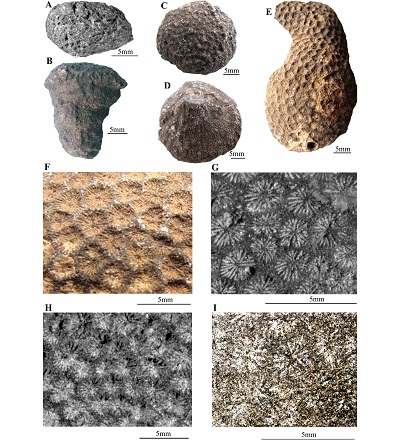 |
| Figure 10. Scleractinian corals from the Nayband Formation, southwest of Ardestan, Central Iran, Iran. (A, B) Astraeomorpha crassisepta (Reuss, 1854). SH-PNUICO8425, Biostrome 1, Section C, Dizlu area. (A) Colony in calicular view. (B) Colony in side view. (C, D) Astraeomorpha confusa (Winkler,1861). SH-PNUICO8445, Biostrome 2, Section C, Dizlu area. (C) Colony in calicular view. (D) Colony in proximal view. (E–G) Chondrocoenia schafhaeutli (WINKLER,1861). E, F. SH-PNUICO8444, Biostrome 2, Section C, Dizlu area. (E) Colony in calicular view. (F) Detail of colony in calicular view. (G) SH-PNUICO8446, Biostrome 2, Section C, Dizlu area. Colony in calicular view. (H, I) Crassistella juvavica (Frech, 1890). (H) SH-PNUICO8436, Biostrome 1, Section C, Dizlu area. Colony in calicular view. (I) SH-PNUICO8438, Biostrome 2, Section C, Dizlu area. Colony in transverse section. |
Family Margarophylliidae CUIF, 1977
Genus Margarophyllia VOLZ, 1896
Type species: Montlivaltia capitata Münster, 1841
Remarks: Three taxa have been here attributed with a reserve to the genus Margarophyllia known up to now from the late Carnian.
Margarophyllia cf. capitata (MÜNSTER, 1841)
Figures 8H and 8I
Material: Four specimens (SH-PNUICO8411, 8415, 8417, 8420) from Biostrome 1, and 2 specimens (SH-PNUICO8421 and 8422) from Biostrome 2, Section C, Dizlu area. Measurements (in mm):
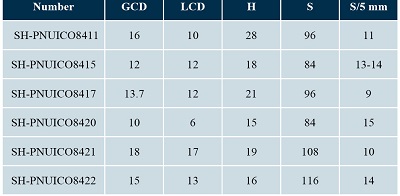
Description: Corallum solitary, conical, slightly curved proximally, subcircular in section, with short calicular fossa. Calice ellipsoid and deep. Septa spindle-like, differentiated into several size orders. The S1 septa are the thickest, reach to the calicular fossa with their axial margins, which dissociate into fragments. Septal blades of the S2 septa are shorter and slightly thinner than the S1 septa, the septa S3 are longer than half the length of the S1 septa. Other septal features: lateral flat granulation and denticulation on distal edge can be observed. Endotheca vesicular, built of small dissepiments. Epithecal wall pellicular and fragile, the best preserved proximally.
Occurrence: Late Triassic, Norian–Rhaetian, Bidestan Member and Howz-e-Khan Member, Dizlu, southwest of Ardestan, Central Iran.
 |
| Figure 11. Scleractinian corals from the Nayband Formation, southwest of Ardestan, Central Iran, Iran. (A–I) Stylophyllopsis polyactis (French, 1890). (A–C) SH-PNUICO8383, Biostrome 2, Section C, Dizlu area. (A) Corallum in calicular view. (B) Corallum in side view. (C) Corallum in proximal view, septa subequal in thickness, thin. (D–F) SH-PNUICO8391, Biostrome 2, Section C, Dizlu area. (D) Corallum in calicular view. (E) Septal spines in corallum. (F) Corallum in proximal view. (G, H) SH-PNUICO8398, Biostrome 2, Section C, Dizlu area. (G) Corallum in calicular view. (H) Corallum in proximal view. (I) SH-PNUICO8389, Biostrome 2, Section C, Dizlu area. |
Margarophyllia cf. crenata (MÜNSTER, 1841)
Figures 8A to 8G
Material: Six specimens (SH-PNUICO8409, 8410, 8414, 8418, 8412, 8419) from Biostrome 1, Section C, Dizlu area.
Measurements (in mm):
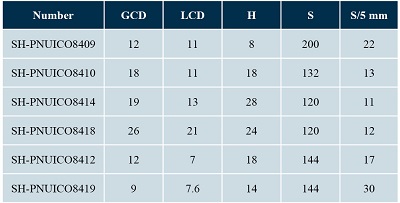
Description: Corallum solitary, conical in shape slightly curved proximally. Calice circular to ellipsoid, from slightly deepened to shallow, with short calicular fossa. Septa thin, spindle-like, differentiated into 3 size orders. The S1 septa continue to the calicular fossa and their axial margins dissociate into fragments; the S2 septa are shorter; the S3 septa are longer than half the length of S2 septa. Granulation on septal faces and denticulation of distal septal margin can be observed. Endotheca vesicular, made of small dissepiments. Epitheca thin, generally preserved proximally, frequently destroyed.
Occurrence: Late Triassic, Norian–Rhaetian, Bidestan Member, Dizlu, southwest of Ardestan, Central Iran.
Margarophyllia sp.
Figures 8J to 8K
Material: One specimen (SH-PNUICO8416) from Biostrome 1, Section C, Dizlu area. Measurements (in mm):

Description: Corallum solitary, conical in shape, calice ellipsoid, deep. Septa thick, with denticulation on the distal edge. Septal blade of the S1 septa reaching to axial cavity, septal blades of the S2 are shorter at about a half and thinner from the S1 septa. Septa of other orders are hardly identifiable. Endotheca made of small dissepiments. Lower part of the corallum is covered with epitheca but in the upper part of corallum, epitheca is destroyed.
Occurrence: Late Triassic, Norian–Rhaetian, Bidestan Member, Dizlu, southwest of Ardestan, Central Iran.
Genus Distichomeandra CUIF, 1976
Type species: Distichomeandra spinosa Cuif, 1976
Distichomeandra austriaca (FRECH, 1890)
Figure 6K
Material: Two specimens (SH-PNUICO8431, 8432) from Biostrome 2, Section C, Dizlu area.Measurements (in mm):

Description: The specimen SH-PNUICO8432 is characterized by polygonal, shallow and monocentric calices and some parts of colony with short calicular series. A new corallite appears as a new center in the extended portion of the adult. Septa thin, arranged into 3 size orders. Septal blades of the S1 septa are thick and continue to axial cavity, septal blades of the S2 septa are shorter and thinner than the S1 septa; the S3 septa are half of the S1 septa in length. Granules are present on the septal faces, they are round or elongate. Endotheca vesicular, concave.
Remarks: The coral resembles D. austriaca in the form of colony, mode of budding, and thick septa, but differs from it in larger diameters of corallites.
Occurrence: Late Triassic, Rhaetian, Howz-e-Khan Member, Dizlu, southwest of Ardestan, Central Iran.
The species is known in the Rhaetian of the Northern Calcareous Alps, in the Zlambach Beds of the Gosaukamm region, and in Fischerwise (Roniewicz, 1989).
Family Cyclophyllidae RONIEWICZ, 1989
Genus Kompsasteria RONIEWICZ, 1989
Kompsasteria oligocystis (FRECH, 1890)
Figure 7I
1890 Isastraea oligocystis: FRECH, p. 24, pl. 5,
figs. 8, 8 A, 8 b, 8 B
1989 Kompsasteria oligocystis (FRECH, 1890): RONIEWICZ, p. 30, pl. 2, figs. 2, 3, pl. 3, figs. 1–5
Material: One sample from Biostrome 2 (SH-PNUICO8433), Dizlu area.
Measurements (in mm):

Description: The specimen SH-PNUICO8433 is characterized by shallow, polygonal, monocentric calices and short, monolinear calicular series. A new corallite appear as a new center in the extended portion of the adult.
Septa thin, arranged into 3 size orders. Septal blades of S1 septa continue to axial cavity, septal blades of S2 septa are shorter and thinner than S1 septa, S3 septa are half of the S1 septa in length. Granules are present on the septal faces, they are round or elongate. Endotheca vesicular, endothecal surface is concave.
Remarks: With its very thin wall and septa, and large corallites, the coral answers to descriptions of K. oligocystis.
Occurrence: Late Triassic, Rhaetian, Howz-e-Khan Member, Dizlu, southwest of Ardestan, Central Iran.
The species is known from the Zlambach Beds of Schneckengraben and Kesselwand-Rohrmoos in the Northern Calcareous Alps (Roniewicz, 1989).
 |
| Figure 12 Scleractinian corals from Nayband Formation, southwest of Ardestan, Central Iran, Iran. (A-F) Stylophyllopsis polyactis (French, 1890). (A–C) SH-PNUICO8393, Biostrome 2, Section C, Dizlu area. (A) Corallum in calicular view. (B) Corallum in side view. (C) Corallum in proximal view. (D–F) SH-PNUICO8394, Biostrome 2, Section C, Dizlu area. (D) Corallum in calicular view. (E) Corallum in transverse section. (F) Corallum in side view. (G, H) Pamirophyllum iranicum (Melnikova, 1972) SH-PNUICO8423, Biostrome 1, Section C, Dizlu area. (G, H) Colony in calicular view. (H) septa of four size orders marked with dots in the following colors: S1 white, S2 yellow, S3 red, S4 blue. |
Family Procylolitidae Vaughan, and Wells, 1943
Genus Procyclolites FRECH, 1890
Type species: Procyclolites triadicus FRECH, 1890
Procyclolites triadicus FRECH, 1890
Figure 6 J
1890 Procyclolites triadicus: FRECH, p. 64, pl. 18, figs. 1–16, text-fig. p. 65
1989 Procyclolites triadicus FRECH: RONIEWICZ, p. 85, pl. 23, figs. 1–3, pl. 24, figs 1, 2
Material: One specimen (SH- PNUICO 8401) from Biostrome 1, Section C, Dizlu area.
Measurements (in mm):

Description: Calice slightly concave. Radial elements thin, numerous, equal in thickness. Lateral faces covered by menianes.
Occurrence: Late Triassic, Norian–Rhaetian, Bidestan Member, Dizlu, southwest of Ardestan, Central Iran.
The species is known in the Rhaetian of the Northern Calcareous Alps: in the Zlambach Beds of Fischerwise and Kesselwand-Rohrmoos (Roniewicz, 1989); reported from Halstatter Salzberg and Zlambachgraben (Frech, 1890).
Family Astraeomorphidae FRECH, 1890
Genus Astraeomorpha REUSS, 1854
Type species: Astraeomorpha crassisepta
REUSS, 1854
Astraeomorpha crassisepta REUSS, 1854
Figures 10A and 10B
1854 Astraeomorpha crassisepta: REUSS, p. 127, 16, figs. 4–7
1890 Astraeomorpha crassisepta REUSS: FRECH, p. 66, text-fig. on p. 70, pl. 19, figs. 14–18
1980 Astraeomorpha crassisepta REUSS: SENOWBARI-DARIAN, p. 38, pl. 2, fig. 3
1986 Astraeomorpha crassisepta REUSS:
MELNIKOVA, p. 56, pl. 20, figs. 1–3, pl. 21, fig. 2
1989 Astraeomorpha crassisepta REUSS: RONIEWICZ, p. 94, pl. 28, figs. 3–5
Material: One specimen (SH-PNUICO8425) from Biostrome 1, Section C, Dizlu area.
Measurements (in mm):

Description: Colony thamnasteroid, columnar in shape, septa not abundant, septal density low, endotheca formed by thin and vesicular dissepiments.
Occurrence: Late Triassic, Norian–Rhaetian, Bidestan Member, Dizlu, Southwest of Ardestan, Central Iran.
The species is present in the Norian and Rhaetian of the Northern Calcareous Alps: Zlambach Beds of Fischerwise, vicinity of Gosaukamm, Zlambachgraben, Hallstätter Salzberg and Scharitzkehralp; Rhaetian limestones of Tyrol; Rhaetian of the Southern Alps (Lombardy); Norian–Rhaetian of the Caucasus, Central Asia; Timor and NE Asia (Roniewicz, 1989). According to Stanley (1986), it is present in the Norian of North America.
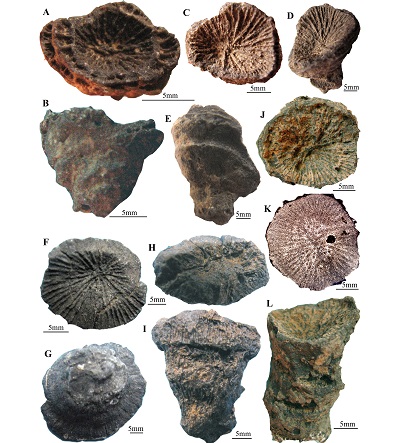 |
| Figure 13. Scleractinian corals from the Nayband Formation, southwest of Ardestan, Central Iran, Iran. (A–G) Stylophyllopsis rudis FRECH, 1890. (A, B) SH-PNUICO8392, Biostrome 2, Section C, Dizlu area. (A) Corallum in calicular view. (B) Corallum in side view, thick—septal morphotype. (C–E) SH-PNUICO8387, Biostrome 2, Section B, Bagher Abad area. (C) Corallum in calicular view. (D) Corallum in calicular and side views. (E) Corallum in side view, thin—septal morphotype. (F, G) SH-PNUICO8378, Biostrome 1, Section C, Dizlu area. (F) Corallum in calicular view. (G) Corallum in proximal view. (H–L) Stylophyllopsis cf. lindstroemi Frech, 1890. (H, I) SH-PNUICO8381, Biostrome 2, Section C, Dizlu area. (H) Corallum in calicular view. (I) Corallum in side view, septa are very thin. (J–L) SH-PNUICO8386, Biostrome 2, Section C, Dizlu area. (J) Corallum in calicular view. (K) Corallum in transverse section. (L) Corallum in side view. |
Astraeomorpha confusa (WINKLER, 1861)
Figures 10C and 10D
1861 Thamnastraea confusa: WINKLER, p. 488, pl. 8, fig. 10
1890 Astraeomorpha confusa WINKLER: FRECH, p. 67, pl. 19, figs. 2, 3, 5, 6, 8, 10, 13
1979 Astraeomorpha confusa (WINKLER): SCHÄFER, p. 46, pl. 10, fig. 3
1980 Astraeomorpha confusa (WINKLER):
KRISTIAN-TOLLMANN, TOLLMANN and HAMEDANI, p. 171, pl. 4, fig. 3
1986 Astraeomorpha confusa (WINKLER):
MELNIKOVA, p. 57, pl. 20, fig. 4, pl. 21, fig. 1
1989 Astraeomorpha confusa WINKLER: RONIEWICZ, p. 96, pl. 28, figs. 1, 2; pl. 29, figs. 1–3
Material: One specimen (SH-PNUICO8445) from Biostrome 2, Section C, Dizlu area. Measurements (in mm):

Description: Thamnasterioid, fungiform; calices arranged in several series. In the intercalicular zone, septa are subparallel. Columella present, synapticulae numerous, dissepiments thin.
Occurrence: Late Triassic, Rhaetian, Howz-e-Khan Member, Dizlu, southwest of Ardestan, Central Iran.
The species is common in the Norian and Rhaetian of the Alps, Caucasus, Central Asia, and Timor (Roniewicz, 1989). Kristian-Tollmann et al. (1980) reported it from the Rhaetian of Iran. According to Stanley (1986) it is present in the Norian of North America.
Genus Chondrocoenia RONIEWICZ, 1989
Type species: Prionastraea schafhaeutli WINKLER, 1861
Chondrocoenia schafhaeutli (WINKLER, 1861)
Figures 10E to 10G
1861 Prionastraea? Schafhaeutli: WINKLER, p. 488, pl. 8, fig. 11
1890 Stephanocoenia schafhäutli WINKLER: FRECH, p. 37, text-fig. on p. 36 (A, B) and two text-figs. on p. 37
1980 Stephanocoenia schafhaeutli FRECH: SENOWBARI-DARYAN, p. 41, pl. 5, fig. 1
1980 Astrocoenia schafhaeutli (WINKLER): KRISTIAN-TOLMANN, TOLLMANN and HAMEDANI, p. 169, pl. 1, figs. 1–4
1989 Chondrocoenia schafhaeutli (WINKLER): RONIEWICZ, p. 104, pl. 33, figs. 1–3, 5
Material: Tree specimens (SH-PNUICO8442, 8443, 8445) from Biostrome 2, Section B, Bagher Abad area, and two specimens (SH-PNUICO8444, 8446) from Biostrome 2, Section C, Dizlu area.Measurements (in mm):

Description: Colonies of plocoid type, lamellate or hemispherical in shape. Lamellate colonies may be large but hemispherical colonies are about 30 mm in diameters. Calices are shallow, polygonal or rounded, columella thin, styliform and oval in form. Septa do not continue to the columella. New corallites appear between adult corallites. Ornamentation of the septal faces granular. Septa arranged into 2 size orders. The S1 septa approach near to the collumela; the S2 septa are shorter than the S1. Endotheca dissepimental, wall thin.
Occurrence: Late Triassic, Rhaetian, Howz-e-Khan Member, Dizlu and Howz-e-Khan Member, Bagher Abad, southwest of Ardestan, Central Iran.
According to Roniewicz (1989), the species is present in the Rhaetian of the Northern Calcareous Alps: Zlambach Beds of Fischerwise and Kesselwand-Rohrmoos, Kössen Beds of Kothalp and Voralpe near to Altenmarkt; Rhaetian of the Southern Alps (Lombardy); Rhaetian of the Carpathians; Norian–Rhaetian of the Pamirs and Afghanistan.
The species was described from the Rhaetian of Iran by Kristian-Tollmann et al. (1980). According to Stanley (1986), it is known from the Norian of North America.
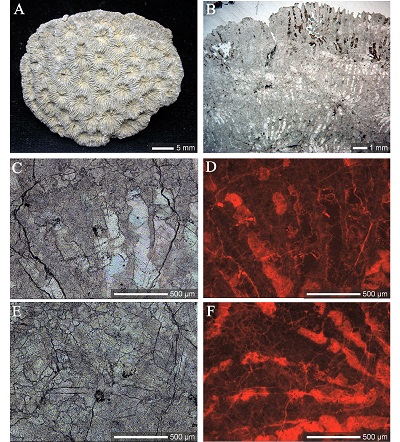 |
| Figure 14. Scleractinian corals from the Nayband Formation, southwest of Ardestan, Central Iran, Iran. (A–F) Pamiroseris rectilamellosa (Winkler, 1861), SH-PNUICO8449, Biostrome 2, Section. B, Bagher Abad area. (A) Colony in calicular view. (B) Thin-sectioned corallum in optical microscope. (C–F) Enlargements of thin-sectioned coralla. (C, E) Enlargements of thin-sectioned coralla in optical microscope view. (D, F) Enlargements of thin-sectioned coralla in cathodoluminescence microscope view. No distinct features of primary microstructure (calcification centers/fibers) are recognizable in the skeleton. However, in cathodoluminescence, the septal regions are much darker in comparison to interseptal deposits (strong red luminescence). Although septal structure is clearly diagenetically altered, secondary, Mn-enriched deposits (showing strong red-luminescence) were formed in interseptal spaces. |
Family Pamiroseriidae MELNIKOVA, 1984
Genus Pamiroseris MELNIKOVA, 1971
Type species: Thamnastraea meriani STOPPANI, 1860
Pamiroseris meriani (STOPPANI, 1860)
Figures 9E and 9F
1858-1860 Thamnastraea meriani: STOPPANI, p. 108, pl. 26, figs. 3–6
1971 Pamiroseris meriani (STOPPANI):
MELNIKOVA, p. 34, pl. 2, fig. 2
2001 Pamiroseris meriani (STOPPANI):
MELNIKOVA, p. 74, pl. 19, figs. 2–4, pl. 24, fig. 4
Material: Five specimens (SH- PNUICO 8459, 8460, 8461, 8463, 8464) from Biostrome 2, Section B, Bagher Abad area. Two specimens (SH-PNUICO8462, 8465) from Biostrome 2, Section C, Dizlu area. Measurements (in mm):
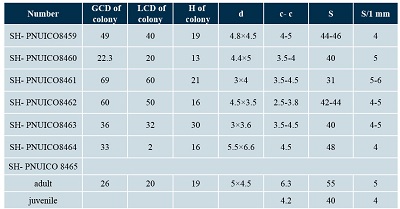
Description: Thamnasterioid colonies, flat or fungi-form with a small trunk, shallow calices, thick wall, granulation on septal faces, denticulation on distal edge of septa. Columella well developed.
Occurrence: Late Triassic, Rhaetian, Howz-e-Khan Member, Dizlu and Howz-e-Khan Member, Bagher Abad, southwest of Ardestan, Central Iran. This species was described from the Rhaetian of the Alps and Pamirs (Roniewicz, 1989).
Pamiroseris rectilamellosa (WINKLER, 1861)
Figures 9A, 9B and Figures 14A to 14F
1861 Thamnastraea rectilamellosa: WINKLER, p. 487, pl. 8, fig. 7
1890 Thamnastraea rectilamellosa WINKLER: FRECH, p. 60, text-fig. on p. 61, pl. 16, figs. 1–15
1979 Thamnasteria rectilamellosa WINKLER: SCHÄFER, p. 46, pl. 1, fig. 3
1980 Thamnasteria rectilamellosa (WINKLER): KRISTAN-TOLMANN, TOLLMANN and HAMEDANI, p. 169, pl. 2, figs. 1–3
1986 Pamiroseris rectilamellosa (WINKLER):
MELNIKOVA, p. 63, pl. 25, figs. 1, 2, pl. 26, fig. 1
1989 Pamiroseris rectilamellosa (WINKLER): RONIEWICZ, p. 111, pl. 34, figs. 3–5
Material: Four specimens (SH- PNUICO 8446-8449) from Biostrome 2, Section B, Bagher Abad area. Six specimens (SH-PNUICO8450-8455) from Biostrome 2, Section C, Dizlu area.Measurements (in mm):
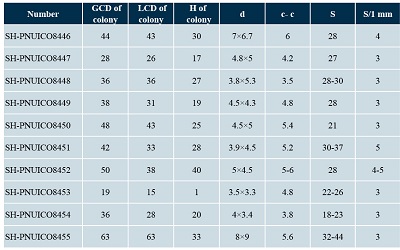
Description: Thamnasteroid colonies, septa are sigmoid or straight in form. On the internal edge, trabecular denticles are present. Septa arranged into 2–3 orders. The S1 septa are long and thick, the S2 septa are short. Septal faces are covered by circular and flat granules. At the margin of colonies, corallites are arranged in series but at the center of colonies, the corallite arrangement is homogeneous. New centers appear between calices and then septal apparatuses of new corallites are organized. In the periaxial ring, endotheca is depressed while at the center of corallite it is convex. No distinct features of primary microstructure (calcification centers/fibers) are recognizable in the skeleton. However, in cathodoluminescence, the septal regions are much darker in comparison to interseptal deposits (strong red luminescence). Although septal structure is clearly diagenetically altered, secondary, Mn-enriched deposits (showing strong red-luminescence) were formed in interseptal spaces (Figures 14A to 14F).
Occurrence: Late Triassic, Rhaetian, Howz-e-Khan Member, Dizlu and Howz-e-Khan Member, Bagher Abad, southwest of Ardestan, Central Iran.
The species is common in the Rhaetian of the Northern Calcareous Alps: in HallstätterSalzberg, Oedalm, Zlambachgraben (Frech, 1890), in Zlambach Beds of Fischerwise, Dachsteinkalk of the Donnerkogels, Dachsteinkalkand the Hochfeln, Rhaetian of the Voralpe near Altenmarkt, Kothalp; in the Rhaetian of the Tatra Mountains, and in the Norian–Rhaetian of the Caucasus and Pamirs (Roniewicz, 1989). The species is known from the Rhaetian of Iran by Kristian-Tollmann et al. (1980).
Pamiroseris multiseptata (MELNIKOVA, 1967)
Figures 9C and 9D
1967 Fungiastraea multiseptata: Melnikova, p. 24, 2, fig. 3
1975 Pamiroseris multiseptatum Melnikova:
MELNIKOVA, p. 131, pl. 30, figs. 1, 2
2001 Pamiroseris multiseptata Melnikova:
MELNIKOVA, p. 75, pl. 19, fig. 5, pl. 22,
fig. 3, pl. 24, fig. 3
Material: One specimen (SH-PNUICO8457) from Biostrome 2, Section B, Bagher Abad area. Two specimens (SH-PNUICO8456, 8458) from Biostrome 2, Section C, Dizlu area. Measurements (in mm):

Description: Thamnasterioid colonies, flat or fungi-form with a small trunk, shallow calices, and thick wall. Corallites have many septa of sigmoid or straight form, and they are larger than corallites in Pamiroseris rectilamellosa.
Occurrence: Late Triassic, Rhaetian, Howz-e-Khan Member, Dizlu and Bagher Abad, southwest of Ardestan, Central Iran.
The species is known from the Rhaetian of the Pamirs (Roniewicz, 1989).
Genus Crassistella RONIEWICZ, 1989
Type species: Stephanocoenia juvavica FRECH, 1890
Crassistella juvavica (FRECH, 1890)
Figures 10H and 10I
1890 Stephanocoenia juvavica: FRECH, p. 38, the left text-fig. on p. 38
1980 Actinastraea juvavica (FRECH): SENOWBARI-DARYAN, p. 42, pl. 5, fig. 3
1989 Crassistella juvavica FRECH: RONIEWICZ, p. 113, pl. 34, figs. 1, 2, pl. 35, figs. 1, 2
Material: Four specimens (SH-PNUICO8434 -8437) from Biostrome 1 and two specimens (SH-PNUICO8438, 8439) from Biostrome 2, Section C, Dizlu area. Two specimens (SH-PNUICO 8440, 8441) from Biostrome 2, Section B, Bagher Abad area. Measurements (in mm):
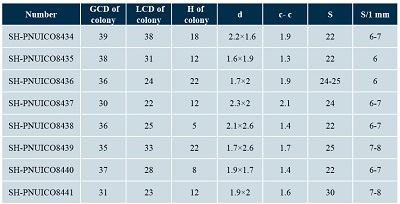
Description: The species is characterized by flat and lamellate or massive and mamillate colonies. Mamillae grow up like columns. Calices are deep, columella small and wall is thick. Corallites increased by division into two juvenile corallites. Septal faces are ornamented with round granules. Septa are wedge-like, differentiated into 2–3 size orders, septal blades of the S1 septa and the S2 septa are subequal, they continue to columella. The S3 septa are half of the length of the S1 septa. Endotheca is formed of abundant, thin-walled vesicles, sub-horizontal or convex in the center of the corallite.
Occurrence: Late Triassic, Norian–Rhaetian, Bidestan and Howz-e-Khan Members, Dizlu and Rhaetian, Howz-e-Khan Member, Bagher Abad, southwest of Ardestan, Central Iran.
The species is known in the Rhaetian of the Northern Calcareous Alps: in the Zlambach Beds of Schneckengraben and Kesselwand-Rohrmoos; the Gruber Reef; dubious in Fischerwise; Norian–Rhaetian of the Pamirs and NE Asia (Roniewicz, 1989).
Family Stylophyllidae FRECH, 1890
Genus Stylophyllopsis FRECH, 1890
Type species: Stylophyllopsis polyactis FRECH, 1890 (designated by DIENER, 1921).
Stylophyllopsis polyactis FRECH, 1890
Figures 11A to 11I and 12A to 12F
1890 Stylophyllopsis polyactis: FRECH, p. 48, text-fig. on p. 49, pl. 12, fig. 3, pl. 15, figs. 17–23
1972 Stylophyllopsis polyactis FRECH: CUIF,239, text-fig. 14 a–c
1989 Stylophyllopsis polyactis FRECH:
RONIEWICZ, p. 124, pl. 36, figs. 6, 7, 37, fig. 1, pl. 38, figs. 8, 9
Material: Eight specimens (SH-PNUICO8383, 8385, 8389, 8391, 8393, 8394, 8398, 8400) from Biostrome 2, Section C, Dizlu area and two specimens (SH-PNUICO8388, 8395) from Biostrome 2, Section B, Bagher Abad area.Measurements (in mm):

Description: Corallum solitary, sub-cylindrical to conical in shape, with circular and shallow calice. Axial cavity filled with septal spines. Septa thin, arranged into 3–4 size orders. Septal blades of the S1 and S2 septa continue to the axial cavity. The S4 septa are the shortest of all. Wall thick.
Occurrence: Late Triassic, Rhaetian, Howz-e-Khan Member, Dizlu and Howz-e-Khan Bagher Abad, southwest of Ardestan, Central Iran.
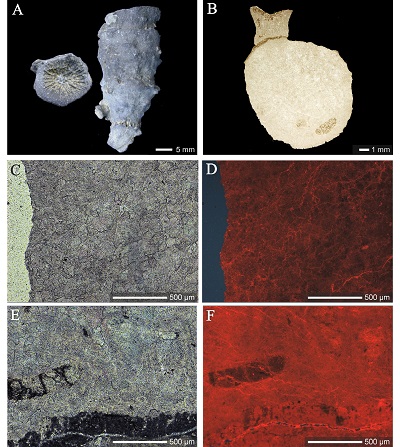 |
| Figure 15. Scleractinian corals from the Nayband Formation, southwest of Ardestan, Central Iran, Iran. (A–F) Solitary Stylophyllopsis rudis (Emmrich, 1853), SH-PNUICO8379, Biostrome 2, Section C, Dizlu area. (A) Corallum in calicular (left) and lateral (right) views. (B) Transversely thin-sectioned corallum (juvenile specimen attached to the adult corallum (upper part of the picture) sectioned longitudinally). (C–F) Enlargements of thin-sectioned coralla. (C, E) Enlargements of thin-sectioned coralla in optical view. (D, F) Enlargements of thin-sectioned coralla in cathodoluminescence microscope view. Coralla are entirely recrystallized (no signs of original microstructure), which is also confirmed by their strong red-luminescence. |
The species is common in the Rhaetian of the Northern Calcareous Alps: in the Zlambach Beds of Fischerwise, Kesselwand–Rohrmoos, Schneckengraben and HallstätterSalzberg (Roniewicz, 1989).
Stylophyllopsis rudis (EMMRICH, 1853)
Figures 13A to 13G and 15A to 15F
1853 Fungia rudis-EMMRICH, p. 378
1890 Stylophyllopsis rudis EMMRICH: FRECH, p. 50, pl.12, figs. 1, 4-14
1980 Stylophyllopsis mojsvari FRECH: KRISTAN TOLLMANN, TOLLMANN and HAMEDANI, p. 173, pl. 5, fig. 3
1989 Stylophyllopsis rudis EMMRICH: RONIEWICZ, p. 126, pl. 39, figs. 2–6, 40, figs. 1, 2, pl. 42, fig. 7
Material: One specimen (SH-PNUICO8378) from Biostrome 1, seven specimens (SH-PNUICO8379, 8380, 8384, 8390, 8392, 8396, 8397) from Biostrome 2, Section C, from Dizlu area, and three specimens (SH-PNUICO8387, 8399 and 8382) from Biostrome 2, Section B, Bagher Abad area.Measurements (in mm):
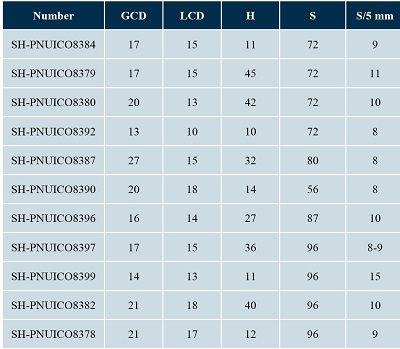
Description: Corallum solitary, conical to horn-like in form, calice subcircular and shallow, septal spines in the axial cavity. This species has thin-septal morphotype (SH-PNUICO8387) and thick-septal morphotype (SH-PNUICO8392). Radial elements arranged into 4 size orders: the S1 septa continuing near to the axial cavity; the S2 septa shorter and slightly thinner than the S1 septa; the septa of the last order are very short, wall thick. Coralla are entirely recrystallized (no signs of original microstructure) that is also confirmed by their strong red-luminescence (Figures 15A to 15F).
Occurrence: Late Triassic, Norian–Rhaetian, Bidestan and Howz-e-Khan Members, Dizlu and Howz-e-Khan Bagher Abad, southwest of Ardestan, Central Iran.
The species is known in the Rhaetian of the Northern Calcareous Alps, Iran, and the Pamirs. In the Alps, it is common in the Zlambach Beds of Fischerwise, Kesselwand-Rohrmoos, and in the Kössen Beds from Kothalp (Roniewicz, 1989). The species was described from the Rhaetian of Iran (Kristian-Tollmann et al., 1980).
Stylophyllopsis cf. lindstroemi FRECH, 1890
Figures 13H to 13L
Material: Two well preserved specimens (SH-PNUICO8386 and 8381) from Biostrome 2, Dizlu area.Measurements (in mm):

Description: Corallum solitary, sub-cylindrical in shape, calice circular, slightly deepened. Septal spines extend to the axial cavity. Septa very thin, arranged into 3–4 size orders. Septal spines of the septa S1 continue to the center, the S2 septa are shorter than the S1 septa, the S3 septa are about a half of the length of the septa S1, the septa S4 are short and very thin. Wall thick.
The specimen SH-PNUICO8381 shows a deformed, flattened calice.
Remarks: The coral, having thin septal spines in which it resembles Rhaetian S. lindstroemi, shows large calices and septa much exceeding in number the septa of the latter species.
Occurrence: Late Triassic, Rhaetian, Howz-e-Khan Member, Dizlu, southwest of Ardestan, Central Iran.
Genus Pamirophyllum Melnikova and
Roniewicz, 1990
Pamirophyllum iranicum MELNIKOVA, 1972
Figures 12G and 12H
1972 Stylophyllum iranicum: MELNIKOVA, p. 59, pl. 10, fig. 3
1975 Stylophyllum iranicum MELNIKOVA:
MELNIKOVA, p. 77, pl. 9: 2, pl. 10: 1
1990 Pamirophyllum iranicum MELNIKOVA:
MELNIKOVA and RONIEWICZ, p. 5, 21, fig. 1
Material: One specimen (SH-PNUICO8423) from Biostrome 1, Dizlu area. Measurements (in mm):

Description: SH-PNUICO8423: colony cerioid, calices polygonal and deep with high and sharp edges; septal faces with small granulations. Axial cavity filled with papillary columella. Septa arranged into 3 size orders. Septal blades of the S1 septa continue to the axial cavity, septa of higher orders are thinner than the S1 septa and shorter in the order. Dissepiments are small. Corallum surface is covered by thin, epithecal wall.
Occurrence: Late Triassic, Norian–Rhaetian, Bidestan Member, Dizlu, southwest of Ardestan, Central Iran.
Remarks: Melnikova (1972) described this species from the upper Norian of the Shurabe-Nagi, Nayband region, Central Iran.
- Conclusions
The Nayband Formation in the southwest of Ardestan includes five members: Gelkan, Bidestan, Howz-e-Sheikh, Howz-e-Khan, and Qadir. The Bidestan and Howz-e-Khan members form reefal limestone. Fourteen genera and 24 species of scleractinian corals were recognized in these members, which characterize the Norian–Rhaetian stage. Skeletons of all collected corals are diagenetically altered (no original microstructure is preserved) although some specimens show weaker (Figures 14) and some stronger (Figures 15) alteration that is expressed by different intensity of Mn-induced lumienscence in cathodoluminescence microscopy. Scleractinian coral fauna from the Nayband Formation bears resemblance to corals from the Northern Calcareous Alps and Pamirs.
Acknowledgements
The author thanks Ewa Roniewicz and Jarosław Stolarski of the Institute of Paleobiology, Polish Academy of Sciences. I appreciate the Editor-in-Chief, Dr. Antoni Camprubí (Bulletin of the Mexican Geological Society) for granting the permission for the publication, the Associate Editor, Prof. Francisco J. Vega (Institute of Geology, UNAM) for his help in the publishing process, and the reviewers for their valuable effort to upgrade the manuscript of this article, their constructive comments, and their helpful advice.
References
Alloiteau, J., 1952, Madréporaires post-paléozoïques, in Piveteau, J. (ed.), Paris, France, Traite de paléontologie, 1, 539−684.
Beauvais, L., 1981, Sur la taxinomie des Madreporaires Mesoziques: Warszawa, Poland: Acta Palaeontology Polonica, 25(3-4), 345−360.
Bourne, G.C., 1900, The Anthozoa, in Lankester, E.R (ed.), A Treatise on Zoology, Part II. The Porifera and Coelentera: London, U.K., Adam & Charles Black, 368 p.
Brönnimann, P., Zadinetti, L., Bozorghnia, F., Dashti, G.R., Moshtaghian, A., 1971, Lithostratigraphy and foraminifera of the Upper Triassic Nayband Formation, Iran: Paris, France, Revue de Micropaléontologie, 14(5), 7−16.
Clapp, C., Shimer, H.W., 1911, The Sutton Jurassic of the Vancouver group, Vancouver Island: Vancouver Island, Canada, Proceedings of the Boston Society of Natural History, 34, 425−438.
Cuif, J.P., 1966, Sur les rapports des generes de Madreporaires Montlivaltia Lam. et Thecosmüia M. — Edw. et Haimf; et leur presence au Trias: Paris, France, Bulletin de la Société géologique de France, 7, 530−536.
Cuif, J.P., 1972, Recherches sur les Madréporaires du Trias. I. Famille des stylophyllidae: Paris, France, Bulletin du Muséum National d’Histoire Naturelle, 97, 213−296.
Cuif, J.P., 1974, Recherches sur les Madréporaires du Trias. II. Genres Montlivaltia et Thecosmilia: Paris, France, Bulletin du Muséum National d’Histoire Naturelle, 40, 293−400.
Cuif, J.P., 1976, Recherches sur les Madréporaires du Trias. IV. Formes cério-méandroïdes et thamnastérioïdes du Trias des Alpes et du Taurus sudanatolien: Paris, France, Bulletin du Muséum National d’Histoire Naturelle, 381, 65−162.
Cuif, J.P., 1977, Arguments pour une rélation phylétique entre les Madréporaires paléozoïques et ceux du Trias: Paris, France, Mémoires de la Société Géologique de France, 129, 1−54.
Diener, C., 1921, Fossilium catalogus, pars 13, Cnidaria triadica: Berlin, Germany, W. Junk, 46 p.
Douglas, J.A., 1929, A marine Triassic fauna from Eastern Persia: Quarterly Journal of the Geological Society of London, 85, 624−648.https://doi.org/10.1144/gsl.jgs.1929.085.01-04.20
Ehrenberg, C.G., 1834, Die Corallenthiere des rothen Meeres: Wien, Austria, Physikalische Abhandlungen der Koniglichen Akademie der Wissenschaften zu Berlin, 1, 156 p.
Emmrich, H.F., 1853, Geognostische Beobachtungen aus ostlichen bayerischen und den angrenzenden österreichischen Alpen: Wien, Austria, Jahrbuch Geology and Reichsanstalt, 4(1), 326−394.
Fallahi, M., Gruber, B., Tichy, G., 1983, Gastropoden und Bivalven aus dem oberen Teil der Nayband-Formation (Obertrias) von Baqirabad (Isfahan, Iran): Schriftenreihe der Erdwissenschaftlichen Kommissionen, 5, 57−82.
Frech, F., 1890, Die Korallen Fauna der Trias, Die Korallen der Juvavichen Triasprovinz: Stuttgart, Germany, Paleontographica, 37, 1−116.
Fürsich, F., Hautmann, M., Senowbari-Daryan, B., Seyed-Emami, K., 2005, The Upper Triassic Nayband and Darkuh Formations of east-central Iran: Stratigraphy, facies patterns and biota of extensional basins on an accreted terrane: University of Zurich, Germany, Beringeria, 35, 53−133.
Hautmann, M., 2001, Die Muschelfauna der Nayband-Formation (Obertrias, Nor- Rhät) des östlichen Zentraliran: University of Zurich, Germany, Beringeria, 29, 181 p.
Kluyver, H.M., Tirrul, R., Chance, P.N., Johns, G.W., Meixncr, H.M., 1983, Explanatory text of the Naybandan Quadrangle maps 1:250000: Tehran, Iran, Geological Survey of Iran, Geology Quadrangle, 8, 143 p.
Kristian-Tollmann, E., Tollmann, A., Hamedani, A., 1980, Beiträge zur Kenntnis der Trias von persien. II. Zur Rhätfauna von Bagherabad bei Isfahan (Korallen, Ostracoden): Wien, Austria, Mittellungen der Österreichischen Geographischen Gesellschaft, 73, 163−235.
Maeda, M., Taga, N., Siringan, F., 1974, Occurrence and distribution deoxyribonucleic acid-hydrolyzing bacteria in sea water: Bolletin of Ecology, 14(2), 157−169. https://doi.org/10.1016/0022-0981(74)90022-7
Melnikova, G.K., 1967, Novye vidy triassovychakleraktinii Pamira: Moscow, Russia, Paleontologicheskii Zhurnal, 1, 29−31.
Melnikova, G.K., 1971, Novye dannye o morfologii, mikrostructure i systematike pozdnetriasovych Thamnasterioidae: Moscow, Russia, Palaeontologische Zeitschrift, 2, 21−35.
Melnikova, G.K., 1972, K revisii nekotorych pozdnetriasovych i rannejurskich predstaviteley semeystva stylophyllidae volz, 1986: Moscow, Russia, Palaeontologische Zeitschrift, 2, 53−63.
Melnikova, G.K., 1975, Late Triassic scleractinians of the south-eastern Pamirs: Dushanbe, Tajikistan, Donish, 235 p.
Melnikova, G.K., 1984, Novye Pozdnetriasovye Korally otriada Archaeocoeniida Alloiteau, 1952, yugo–vostotshnogo pamira: Dushanbe, Tajikistan, Novye vidy iskopayemoy flory Fauny Tadzhikistana, 42−55.
Melnikova, G.K., 1986, Korally kak indikatory razchisleniya karbonatnykh tolshch, in Parastratigraficheskie gruppy flory i fauny triasa: Leningrad, Russia, Nedra, 30−67.
Melnikova, G.K., 2001, Type of the Coelenterata, in Rozanov, A.U., Sheverev, R.V. (eds.), Atlas of Triasssic Invertebates of the Pamirs, Moscow, Russia, Nauka, 30-80.
Melnikova, G.K., Roniewicz, E., 1990, On a new stylophyllid genus, Pamirophyllum (Scleractinia, Upper Triassic): Warszawa, Poland, Acta paleontology Polonica, 35(1-2), 85−90.
Münster, G.V., 1841, Beschreibung und Abbildung der in den Kalkmergelschichten von St. Cassian gefundenen Versteinungen: Beitrge zur Petrefacten-Kunde, 4, 25−152.
Nützel, A., Senowbari-Daryan, B., 1999, Gastropods from the Late Triassic (Norian–Rhaetian) Nayband Formation of Central Iran: University of Zurich, Germany, Beringeria, 23, 93−132.
Nützel, A., Hamedani, A., Senowbari-Daryan, B., 2003, Some Late Triassic Gastropods from the Nayband Formation in Central Iran: Erlangen, Germany, Facies, 48(1), 127−134. https://doi.org/10.1007/bf02667535
Nützel, A., Mannani, M., Senowbari-Daryan, B., Yazdi, M., 2010, Gastropods from the Late Triassic Nayband Formation (Iran), their relationships to other Tethyan faunas and remarks on the Triassic gastropod body size problem: Neues Jahrbuch für Geologie und Paläontologie Abhandlungen, 256(2), 213−228. https://doi.org/10.1127/0077-7749/2010/0049
Repine, U., 1996, New Late Triassic Bivalves from Iran and a taxonomy of the superfamily Spondylacea: Paleontological Journal, 30(4), 363−369.
Reuss, A.E., 1854, Beiträge zur Charakteristik der kreideschichten in den Ostalpen, besonders im Gosauthale und am Wolfgansee: Wien, Austria, Denkschriften der Kaiserlichen Akademie der Wissenschaften, mathematisch-physikalische Classe, 7, 157 p.
Roniewicz, E., 1974, Rhaetian Corals of the Tatra Mts: Warszawa, Poland, Acta Geologica Polonica, 24(1), 97−116.
Roniewicz, E., 1989, Triassic Scleractinian corals of the zlambach Beds, Northern calcareous Alps, Austria: Denkschriften, Austria, Österreichisch Akademie der Wissenschaften, Mathematisch- Naturwissenchaftliche Klasse, 126, 152 p.
Roniewicz, E., 1996, Upper Triassic solitary corals from the Gosaukamm and other north Alpine regions: Denkschriften, Austria, Österreichisch Akademie der Wissenschaften, Mathematisch-Naturwissenchaftliche Klasse, 202, 3−41
Schäfer, P., 1979, Fazielle Entwicklung und palökologische Zonierung zweier obertriadischer Riffstrukturen in den Nördlichen Kalkalpen (Oberrhät Riff- Kalke, Salzburg): Erlangen, Germany, Facies, 245 p.
Senowbari-Daryan, B., 1980, Fazielle und paläontologische Untersuchungen in obervhätischen Riffen (Feichtenstein und Gruberriff bei Hintersee, Salzburg, Nördliche Kalkalpen): Erlangen, Germany, Facies, 3, 237 p.
Seyed-Emami, K., 1971, A summary of the Triassic in Iran: Tehran, Iran, Geological Survey of Iran, 20, 41−53.
Seyed- Emami, K., 2003, Triassic in Iran: Erlangen, Germany, Facies, 48, 91−106.
Shepherd, H.M.E., Stanley, G.D., Jr., Amirhassankhani, F., 2012, Norian to Rhaetian Scleractinian corals in the Ferdows patch reef (Nayband Formation, East Central Iran): Journal of Paleontology, 86(5), 801−812. https://doi.org/10.1666/12-001.1
Smith, J.P., 1927, Upper Triassic marine invertebrate faunas of North America: US Geological Survey, Professional Paper, 141, 1–261.
Stanley, G.D., Jr., 1986, Late Triassic coelenterate faunas of western Idaho and northeastern Oregon, Implications for biostratigraphy and paleogeography, in Geology of the Blue Montains region of Oregon, Idaho and Washington: Washington, U.S.A., United State Geological survey, Professional Paper, 1435, 23−36.
Stoppanni, A., 1860, Monographie des fossiles de I’Assarola appartenant á la zone superieure des couches a Avicula contorta en Lombardie: Milan, Italy, Paleontology of Lombardie, 24(5-7), 3−116.
Vaughan, T.W., Wells, J.W., 1943, Revision of the suborders, families, and genera of the Scleractinia: Baltimore, U.S.A., Geological Society of American, Special Peper, 44, 363 p.
Volz, W., 1896, Die Korallen der Schichten von St. Cassian Sudtiro1: Stuttgart, Germany, Palaeontographica, 43, 1−124.
Winkler, G., 1861, Der Oberkeuper, nach Studies in den bayerischen Alpen: Berlin, Germany, Zeitschrift Deutschen Geologische Gesellschaft, 13, 459−521.
Zahedi, M., 1976, Explanatory text of the Isfahan Quadrangle, 1:250,000: Tehran, Iran, Geological Survey Of Iran, F8, 49p.
Manuscript received: December 19, 2018
Corrected manuscript received: March 11, 2019
Manuscript accepted: May 24, 2019

